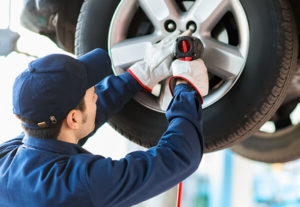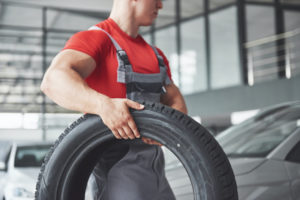Tire Rotation in Tucson, AZ
Make sure you get the most from your investment in your new tires by keeping up with a maintenance schedule that includes tire rotation and tire balancing.
Come to BRAKEmax Tire & Service Centers for expert tire services provided by our ASE-certified technicians at every location.
Tire Rotation Service in Tucson
Proper tire rotation helps your tires wear more evenly and maximizes the life of your tires. Regular tire rotation also allows our tire experts to inspect your tires for other issues that may affect performance.
affect performance.
The mechanics at your nearest Tuscon-area auto shop location will quickly rotate your tires and also let you know if any of your tires are no longer roadworthy. Tires with too much wear can make your vehicle less stable and make driving more dangerous. Worn tires can also increase fuel consumption, as this puts a greater strain on your engine. We can also help you make the best choice of replacement tires if that becomes necessary. Our tire shop carries all major tire brands!
Tire tread wear can cause cupping or wearing on one side of the tire. This changes the way the tire deals with bumps or slopes on the road. You will be able to feel this in the steering, and a car that pulls to one side can be difficult to drive. Plus, fighting this pull to one side can be extremely tiring over long distances.
Tire rotation is one of the simplest ways to extend the life of your tires and ensure your vehicle runs more efficiently. Our goal at BRAKEmax is to prevent tire problems before they happen. And the tire rotation cost is minimal as part of a preventive maintenance package.
Book A Tire Rotation & Balance Appointment
Tucson Tire Rotation Basics
All the tires on your car or truck wear at different rates. This means that rotating the tires on a regular schedule extends tire life by breaking tire wear patterns. On a front-wheel drive vehicle the rear tires should get moved to the front and the front tires to the rear. The goal is to keep the best tires on the front of the car. The front tires tend to wear faster since they are the driving and steering tires. Rotating them regularly will allow for maximum wear from all the tires. This will also create more stability on the road.
driving and steering tires. Rotating them regularly will allow for maximum wear from all the tires. This will also create more stability on the road.
Check your car’s owner’s manual for the recommended rotation pattern or consult our Tucson tire technicians about the best rotation to get the most out of the tire.
Tires that are never rotated can create a dangerous situation for anyone on the road around you as well as those in the car. A blowout of one of your tires, especially at high speeds, can be deadly. Worn tires also strain your engine, increasing fuel consumption.
When you drive into one of our car repair shops for a tire inspection, the tires and wheels on your vehicle will be moved to new positions, but the tire specialists will also check for any other problems while they perform this service. And if any of your tires need to be replaced, our service staff will help you pick out the best tire for you. When you say, “Rotate tires!” much more happens at BRAKEmax.
Tire Rotation Schedule
Tire experts recommend new tires be rotated at 5,000 miles, and then every 6,000 to 8,000 miles after that. New tires have deeper tread, so the tires wear quickly, but, in that case, a longer interval is all that is necessary.
If you make it a habit to have your tires rotated whenever you have your oil changed, you won’t have to remember an additional schedule! Ask one of our Tucson tire rotation mechanics to add this service to your oil change schedule.
Tire Rotation Exceptions
Every guideline or rule has exceptions. This is true for tire rotation, too. Here are some things to keep in mind about rotating the tires on your vehicles:
Directional Tires
The tread on these tires only goes in one direction. For this reason, they must move only from back to front, not from one side of the car to the other. This limits the benefits of tire rotation, so directional tires don’t get as much benefit from being rotated. Check with our Tucson tire repair team about how often to perform this service.
Truck Tires
Truck tires are sometimes not the same on the front and rear axles. This is because load ratings and tread patterns can differ for the needs and type of the truck. Rotation in this case may not always be practical.
Tire Rotation and Balancing Are Not The Same
 Tire balancing is a separate service from tire rotation. Your vehicle will provide a smooth ride as long as the tread on every tire is even and the tires are in balance. In order to accomplish that, each tire needs to weigh exactly the same as the others. But tread wears as it turns on the surface of the road, so the weight changes. The problem is that each tire wears down differently on each wheel assembly, so they become unbalanced. Unbalanced tires can also happen due to damaged wheels or bent rims.
Tire balancing is a separate service from tire rotation. Your vehicle will provide a smooth ride as long as the tread on every tire is even and the tires are in balance. In order to accomplish that, each tire needs to weigh exactly the same as the others. But tread wears as it turns on the surface of the road, so the weight changes. The problem is that each tire wears down differently on each wheel assembly, so they become unbalanced. Unbalanced tires can also happen due to damaged wheels or bent rims.
These weight imbalances cause your car or truck to vibrate or have other performance issues. The tread will also wear faster. The vibrations will get progressively more noticeable the faster the car is moving.
Schedule a Tire Rotation Service in Tucson Today
Tire rotation is essential to ensure your safety and extend the life of your tires. Come to the experts at BRAKEmax Tire & Service Centers for all your tire service needs. Book your appointment at the BRAKEmax location that fits your schedule and geographic area.
Don’t forget to check all the tire rotation and balancing specials and coupons on the BRAKEmax website! Our goals are to provide superior quality auto service, customer service, and the best value in tires and tire care.
Book A Tire Rotation & Balance Appointment
Frequently Asked Questions
If your tires are relatively new, we recommend having them rotated at the 5,000-mile mark because their deeper tread is more susceptible to uneven wear. For older tires, keep to a tire rotation schedule of 6,000 to 8,000 miles to help ensure all of your tires last longer and wear more evenly. At BRAKEmax, we recommend that you have your tires checked and rotated during your regular oil and filter change appointment.
Tire rotation is a task best left to the professionals. Our ASE-certified mechanics will ensure that your tires are properly aligned and moved to the proper position on your car or truck. As we rotate your tires, we will also check your tire pressure and look for any early signs of other types of issues you may have with your tires.
Between the front and rear axles of your vehicle, your tires wear at different rates. So, if you were to leave all your tires in their current positions for an extended period, each one would develop excessive wear where the greatest friction is when braking, turning, or driving straight.
This means that the tires’ tread will wear unevenly without routine tire rotation, creating a rough and potentially unstable surface. This type of tread wear can significantly decrease your vehicle’s safety on the road, possibly causing hydroplaning, excessive heat buildup, poor traction in ice and snow, and increased risk of blowouts or punctures.
Keeping up with consistent tire rotations will ensure more even tire wear and allow the mechanic to visually inspect the tires for any abnormal wear or other issues and catch them early.
A tire rotation is a relatively fast and easy service compared to some other vehicle maintenance services. Usually, a tire rotation service will take anywhere between 30 and 45 minutes.
Of course, that timeframe assumes that you have an appointment. If you haven’t scheduled an appointment and the shop is busy, you may encounter some wait time in addition to the time needed to rotate tires.
Both tire alignment and tire rotation services help ensure even tire wear across all four tires, but a tire rotation will not impact the wheel alignment on your vehicle. So, it isn’t imperative to have the alignment adjusted every time you have a tire rotation done.
But it’s important to follow the recommended schedule for both tire maintenance services. Not only do they both help extend your tires’ lifespan, but they also help detect any other issues that may be present. For example, if your vehicle’s alignment is off, this can often be seen when a tire rotation is performed.








